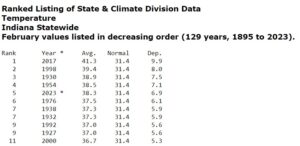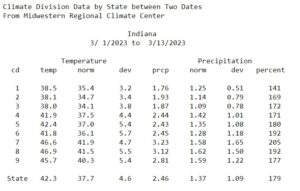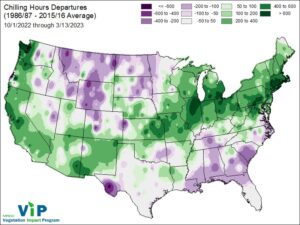It’s official, Indiana had the fifth warmest February on record with an average temperature of 38.3◦F (6.9◦F above normal) and 3◦F behind the all-time record set in 2017 (41.3◦F) (Figure 1). Accompanied with the warm temperatures, February was an exceptionally windy month. The state contended with several storm events causing the windy conditions. Indianapolis recorded 17 days where wind gusts were greater than or equal to 30 mph, 6 days greater than or equal to 40 mph, and two days with winds in excess of 50 mph. February 9th had a 54-mph wind gust and February 27 observed a 56-mph wind gust.
February precipitation has continued to chip away at precipitation deficits as the state average precipitation was 3.18”, which was 0.9 inches above normal. Since March 1, Indiana precipitation averaged 2.46”, which is 179 percent of normal (Figure 2). Improvements to river stream flows, soil moisture, and drought indices allowed for removal of all US Drought Monitor Categories on March 9th, which is the first time being drought category free since May 17, 2022.
March 1-13th temperatures have continued to run above normal as the state average was 4.6◦F above the 1991-2020 normal (Figure 2). Tied to this, temperatures have been in the sweet spot for chilling hours to accumulate this winter and are running above normal across most of the state (Figure 3). This means that many of our perennial crops have reached the number of hours exposed to temperatures within an ideal range during dormancy. Given some bud-break in southern Indiana, freeze potential still lingers and may result in crop damage.
Minimum temperature forecasts are projecting low to mid 20s for much of the state over the coming week. The Climate Prediction Center has higher confidence in below-normal temperatures through March 23 returning to near normal for the final week of the month. If you missed Hans Schmitz’s spring outlook last week, be sure to check it out.


